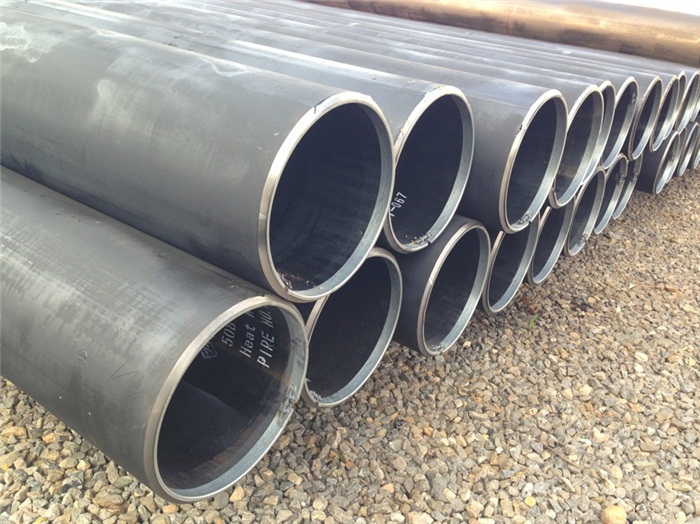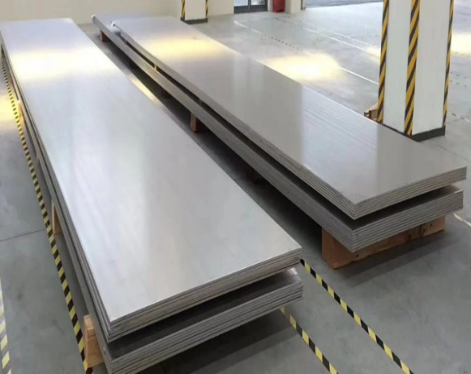There are many measures to prevent welding deformation of welded pipes. Due to the welding deformation of welded pipes is inevitable in welding production. In order to achieve the purpose of controlling the amount of deformation, one or more methods should be selected in production according to the specific type of welding structure.
1.Design measures. Reasonable structural design and weld arrangement play an important role in preventing and reducing welding deformation. In the design. On the basis of considering material saving, convenient manufacture and safe use, it should also consider reducing the number of welds as much as possible. Shorten the length of the weld. The welds should be arranged as symmetrically as possible, and the welds should be symmetrical to the neutral axis of the structural section. Smaller weld grooves and sizes should be used as much as possible; during production, simple assembly of welding molds and clamps should be used.

2. Reserve weld seam shrinkage allowance when blanking. In order to compensate for the linear shortening of the weld seam after welding, the shrinkage allowance can be reserved in advance for control during material preparation and processing through test methods or estimation of the shrinkage of the weld seam.
Since the shrinkage of the weld is related to many factors, it is difficult to calculate. We can only roughly estimate the amount of deformation based on process tests and the accumulation of a large amount of data. The following factors can be considered when estimating.
①Materials with a large linear expansion coefficient have a large linear shrinkage after welding. Stainless steel and aluminum have larger coefficients of linear expansion than mild steel. Therefore, welding deformation is also large.
② The longitudinal shrinkage of the weld increases with the increase of the weld length, and the transverse shrinkage of the weld increases with the increase of the weld width. Generally, the longitudinal shrinkage is measured by the shrinkage per meter of weld, and the transverse shrinkage is measured by the shrinkage of each weld. In the free state of the welded pipe, the transverse shrinkage of the same weld seam by manual arc welding is equivalent to the longitudinal shrinkage of the 2-4m long weld seam. Therefore, when the weld is not too long, the transverse shrinkage of the weld is dominant.
③ The lateral shrinkage of fillet welds is smaller than that of butt welds.
④ The shrinkage of intermittent welds is smaller than that of continuous welds.
⑤ During multi-layer welding, the shrinkage caused by the first layer is the largest, the increased shrinkage of the second layer is about 20% of the shrinkage of the first layer, the third layer increases by 5%-15%, and the last few layers increase even less.
3. Anti-deformation method. In order to offset the welding deformation, when the weldment is assembled, the weldment is artificially deformed in the direction opposite to the welding deformation. This method is called the anti-deformation method.
4.Choose a reasonable assembly welding sequence. The structure is properly divided into parts, assembled and welded separately, and then welded into a whole. Make asymmetric welds or welds with large shrinkage shrink more freely without affecting the overall structure. According to this principle, the complex and large-scale welding structure is not only beneficial to control the welding deformation, but also can expand the working area and shorten the production cycle.
5.Rigid fixation method. Generally speaking, the welding deformation of the weldment with high rigidity is small. The method of using external rigid restraint to reduce welding deformation is called rigid fixation method or restraint method.
The rigid fixing method can use welding fixtures to place heavy objects on the welded pipe or fix the welded pipe on a rigid platform, which can effectively reduce welding deformation. However, it should be pointed out that after welding by the rigid fixing method, a large welding internal stress will often be generated in the weldment. Therefore, for workpieces or welding materials with a large tendency to crack, it is not suitable to use rigid fixing method to control welding deformation.
6.Thermal adjustment method. The thermal adjustment method is to achieve the purpose of reducing welding deformation, using the reduction of welding line energy to reduce the heating area or make uneven heating or cooling as uniform as possible.
1.Design measures. Reasonable structural design and weld arrangement play an important role in preventing and reducing welding deformation. In the design. On the basis of considering material saving, convenient manufacture and safe use, it should also consider reducing the number of welds as much as possible. Shorten the length of the weld. The welds should be arranged as symmetrically as possible, and the welds should be symmetrical to the neutral axis of the structural section. Smaller weld grooves and sizes should be used as much as possible; during production, simple assembly of welding molds and clamps should be used.

2. Reserve weld seam shrinkage allowance when blanking. In order to compensate for the linear shortening of the weld seam after welding, the shrinkage allowance can be reserved in advance for control during material preparation and processing through test methods or estimation of the shrinkage of the weld seam.
Since the shrinkage of the weld is related to many factors, it is difficult to calculate. We can only roughly estimate the amount of deformation based on process tests and the accumulation of a large amount of data. The following factors can be considered when estimating.
①Materials with a large linear expansion coefficient have a large linear shrinkage after welding. Stainless steel and aluminum have larger coefficients of linear expansion than mild steel. Therefore, welding deformation is also large.
② The longitudinal shrinkage of the weld increases with the increase of the weld length, and the transverse shrinkage of the weld increases with the increase of the weld width. Generally, the longitudinal shrinkage is measured by the shrinkage per meter of weld, and the transverse shrinkage is measured by the shrinkage of each weld. In the free state of the welded pipe, the transverse shrinkage of the same weld seam by manual arc welding is equivalent to the longitudinal shrinkage of the 2-4m long weld seam. Therefore, when the weld is not too long, the transverse shrinkage of the weld is dominant.
③ The lateral shrinkage of fillet welds is smaller than that of butt welds.
④ The shrinkage of intermittent welds is smaller than that of continuous welds.
⑤ During multi-layer welding, the shrinkage caused by the first layer is the largest, the increased shrinkage of the second layer is about 20% of the shrinkage of the first layer, the third layer increases by 5%-15%, and the last few layers increase even less.
3. Anti-deformation method. In order to offset the welding deformation, when the weldment is assembled, the weldment is artificially deformed in the direction opposite to the welding deformation. This method is called the anti-deformation method.
4.Choose a reasonable assembly welding sequence. The structure is properly divided into parts, assembled and welded separately, and then welded into a whole. Make asymmetric welds or welds with large shrinkage shrink more freely without affecting the overall structure. According to this principle, the complex and large-scale welding structure is not only beneficial to control the welding deformation, but also can expand the working area and shorten the production cycle.
5.Rigid fixation method. Generally speaking, the welding deformation of the weldment with high rigidity is small. The method of using external rigid restraint to reduce welding deformation is called rigid fixation method or restraint method.
The rigid fixing method can use welding fixtures to place heavy objects on the welded pipe or fix the welded pipe on a rigid platform, which can effectively reduce welding deformation. However, it should be pointed out that after welding by the rigid fixing method, a large welding internal stress will often be generated in the weldment. Therefore, for workpieces or welding materials with a large tendency to crack, it is not suitable to use rigid fixing method to control welding deformation.
6.Thermal adjustment method. The thermal adjustment method is to achieve the purpose of reducing welding deformation, using the reduction of welding line energy to reduce the heating area or make uneven heating or cooling as uniform as possible.









